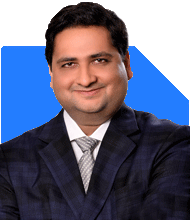Ramalingam Kalirajan |10893 Answers |Ask -Follow
Mutual Funds, Financial Planning Expert - Answered on Apr 26, 2024
He has an MBA in finance from the University of Madras and is a certified financial planner.
He is the director and chief financial planner at Holistic Investment, a Chennai-based firm that offers financial planning and wealth management advice.... more

Dear Sir, I am 45 years old and have the following investments in Mutual Funds and other investments. Kindly review my portfolio and suggest changes as needed. My goals are: retirement and higher education for my son who is 13 years old now AXIS LONG TERM EQUITY FUND REGULAR IDCW PAYOUT - 1 lakh (one time) AXIS MULTICAP FUND-REGULAR PLAN-GROWTH - 1 lakh (one time) DSP TAX SAVER FUND IDCW PAYOUT - 50,000 (one time) ICICI PRUDENTIAL VALUE DISCOVERY FUND IDCW PAYOUT - SIP (5000) SBI BLUE CHIP FUND REGULAR PLAN IDCW PAYOUT - 1 lakh (one time) ICICI Prudential Bluechip Fund -IDCW - 1 lakh (one time) Mirae Asset Emerging Bluechip Fund - Regular Plan Growth - SIP (5000) Tata India Tax Savings Fund Regular Plan IDCW - 50,000 (one time) Thanking You
Retirement Goal:
Given your age, retirement planning is crucial. Your one-time investments in Axis Long Term Equity Fund, Axis Multicap Fund, and SBI Blue Chip Fund are good choices for long-term growth. However, consider diversifying across asset classes to manage risk better. Adding debt or balanced funds can provide stability to your portfolio.
Higher Education Goal:
For your son's education, which is 5 years away, your SIPs in ICICI Prudential Value Discovery Fund and Mirae Asset Emerging Bluechip Fund are well-suited for potential growth. Given the shorter time horizon, you may want to consider gradually shifting to less volatile investment options as the goal approaches.
Portfolio Suggestions:
Diversification: Consider adding debt funds or balanced funds to balance out the equity-heavy portfolio.
Regular Review: Periodically review and rebalance your portfolio to align with your goals and risk tolerance.
SIPs: Continue your SIPs but reassess the funds periodically to ensure they align with your goals and market conditions.
Tax Planning: Given your investments in tax-saving funds, ensure you maximize tax benefits while maintaining a diversified portfolio.
Specific Recommendations:
Retirement: Consider adding a mix of debt funds or balanced funds to your portfolio for stability.
Education: As the education goal approaches, gradually shift to less volatile options to protect the corpus.
Remember, investing is a journey, not a destination. Regularly reviewing and adjusting your portfolio is essential to stay on track towards your goals.
I strongly recommend consulting with a Certified Financial Planner to discuss your portfolio in detail and tailor a strategy that aligns with your aspirations.
You may like to see similar questions and answers below
Ramalingam Kalirajan |10893 Answers |Ask -Follow
Mutual Funds, Financial Planning Expert - Answered on Apr 26, 2024
Ramalingam Kalirajan |10893 Answers |Ask -Follow
Mutual Funds, Financial Planning Expert - Answered on May 30, 2024
Hardik Parikh | Answer |Ask -Follow
Tax, Mutual Fund Expert - Answered on Apr 23, 2023
Ramalingam Kalirajan |10893 Answers |Ask -Follow
Mutual Funds, Financial Planning Expert - Answered on May 31, 2024
Ramalingam Kalirajan |10893 Answers |Ask -Follow
Mutual Funds, Financial Planning Expert - Answered on Jul 04, 2024
Ramalingam Kalirajan |10893 Answers |Ask -Follow
Mutual Funds, Financial Planning Expert - Answered on Dec 15, 2025
Ramalingam Kalirajan |10893 Answers |Ask -Follow
Mutual Funds, Financial Planning Expert - Answered on Dec 15, 2025
Radheshyam Zanwar |6746 Answers |Ask -Follow
MHT-CET, IIT-JEE, NEET-UG Expert - Answered on Dec 15, 2025
Ramalingam Kalirajan |10893 Answers |Ask -Follow
Mutual Funds, Financial Planning Expert - Answered on Dec 15, 2025
Ramalingam Kalirajan |10893 Answers |Ask -Follow
Mutual Funds, Financial Planning Expert - Answered on Dec 15, 2025
Ramalingam Kalirajan |10893 Answers |Ask -Follow
Mutual Funds, Financial Planning Expert - Answered on Dec 15, 2025
Samraat Jadhav |2508 Answers |Ask -Follow
Stock Market Expert - Answered on Dec 15, 2025
Ramalingam Kalirajan |10893 Answers |Ask -Follow
Mutual Funds, Financial Planning Expert - Answered on Dec 15, 2025
Reetika Sharma |425 Answers |Ask -Follow
Financial Planner, MF and Insurance Expert - Answered on Dec 15, 2025
Radheshyam Zanwar |6746 Answers |Ask -Follow
MHT-CET, IIT-JEE, NEET-UG Expert - Answered on Dec 15, 2025










.jpg)















